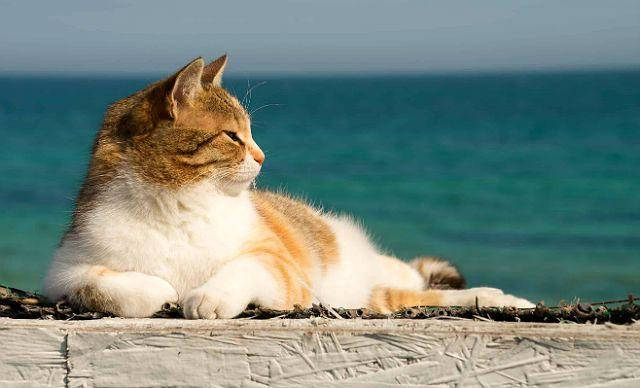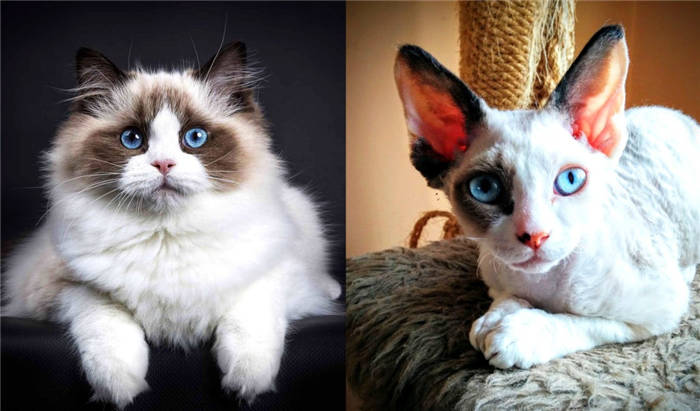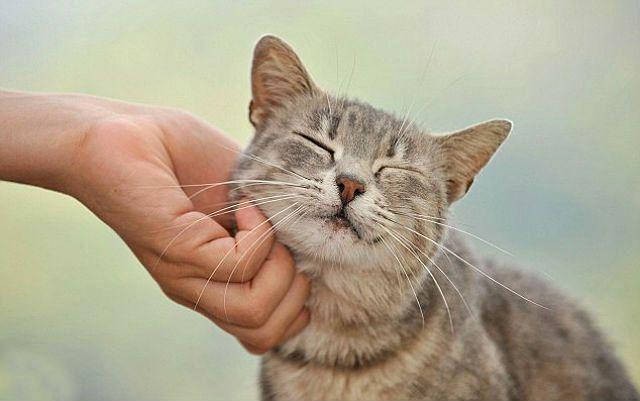Cats, like humans, experience anxiety when a stranger comes into the house. By purring, they soothe themselves. This lowers their blood pressure, slows their heart rate, and calms their nervous system.

Why and how cats purr
Hello! Let's talk about one of the most soothing sounds in the world – the purr of a cat. It's a sound that can instantly calm you down and make you feel warm and fuzzy inside. But have you ever wondered why cats purr and what it means?
First of all, let's talk about how cats make this beautiful sound. It all starts in the throat, where the vocal cords vibrate rapidly. This vibration then spreads throughout the body, causing the diaphragm and other muscles to contract and relax, creating the sound we all know and love.
So, why do cats purr? Turns out cats can purr for a variety of reasons. One of the most common reasons is when they are happy and content. If you pet your cat and she starts purring, it's a sure sign that she's enjoying herself and feels safe and comfortable around you.
But purring is not just a sign of happiness. Cats may also purr when they are hurt or stressed. It is believed that purring can help cats calm down and even heal their bodies. The vibrations created by purring are thought to stimulate bone growth and promote healing of injured areas of the body.
Cats also use purring as a way to communicate with people and other cats. When a cat rubs against your leg and starts purring, it's its way of saying, "Hey, I like you and I trust you." Similarly, when cats purr at each other, it can be a sign of friendship and trust.
Interestingly, not all cats purr the same way. Domestic cats have a triangular hyoid bone, which allows them to purr continuously, both on the inhale and on the exhale. However, big cats, such as tigers and lions, have a rectangular bone under their tongue, which means they can only purr on the exhale.
So is listening to a cat purr helpful? Some studies show that the sound of a cat purring can have a positive effect on your health. The vibrations created by purring are thought to lower blood pressure, reduce stress and anxiety, and even help relieve pain.
Why do cats purr?
Snuggling in a chair with a cat on your lap and listening to it purr – what could be better! That said, cat owners believe that their pets purr when they're comfortable, too. But in fact, it's not that simple. One of the most pleasant sounds for the human ear in many ways remains a mystery even to science.
Even the question "how does it happen?" has long been the subject of debate. Purring is a low-pitched sound that cats make with their mouths closed. Initially, it was assumed that the "purring" was due to the flow of blood to the vein, through which deoxygenated blood travels to the heart. But after more research, scientists decided that the sound is produced by the muscles of the larynx and diaphragm. When the muscles move, they expand and contract the part of the larynx that surrounds the vocal cords. Inhale – exhale, the muscles contract and the air vibrates. This is the mechanism for prolonged purring – but there is still one detail missing from this puzzle. Apparently, the central nervous system is involved in generating the "purr" – but the details of its involvement in this process are still unclear.
Purring is an almost unique feature of felines. Among other carnivores, only some members of the wyvern family (they are descended from common ancestors with cats) can make such sounds. Some other animals make purr-like sounds, but of a completely different nature.
"Vocal ability" has repeatedly become a criterion for classifying felines. So, earlier they were divided into "purring" and "growling", but later such division was abandoned. Modern classification of cats into subfamilies of big and small cats also takes the "purr-factor" into consideration: big cats can purr only when exhaling, and small cats can purr both when exhaling and exhaling. It is noteworthy that small cats include even very large cheetahs and cougars: the classification is not based on size per se, but on more subtle anatomical differences.
Each cat or cat purrs in its own way. Some "turn the sound on full blast," others purr barely audible, while others seem to do almost none at all. In what situations do cats use their amazing ability? The functions of purring seem to be quite varied.
How cats communicate with their own kind by means of their voice
When a cat encounters a "fellow traveler", it makes a purr to let them know that it is in a peaceful mood. It does this to show the other individual its kind disposition. Males often purr near weaker or sick cats. This is their way of letting them know that they do not plan to attack.
According to some zoologists, with the help of special sounds, cats can cure diseases associated with stress and soothe humans. Of course, you can't cure arthritis or hypertension without medical help. But a quiet, calm purr is good for frayed nerves and will definitely bring joy into the home 
What species are capable of purring?
Among domestic cats, ragdolls and Devon Rexes cannot purr. Also such sounds can rarely be heard from the most calm, phlegmatic breeds. But the issue here is not the ability to purr, but the lack of desire to express any emotion.
As for wild cats, all small species such as cheetahs, bobcats, and ocelots are capable of purring. They have more elastic ligaments, as well as a different shape of the hyoid bone in contrast to lions and tigers.

At the same time, species such as leopards, pumas, irbis and smoky leopards remain a real mystery to scientists. Despite their large size and seemingly inappropriate larynx structure, all of them are able to purr.
What cats purr at, scientists have not yet established for sure. But, according to the most likely and widespread theory, the hyoid bones are involved. In cats, they have a triangular shape. The signal of certain emotions goes to the brain, and from there to the organ that sends out the vibrations. The vocal cords are the source of the sound.
If you find a mistake, please highlight text and press Ctrl+Enter.
Purr therapy
A few years ago, scientists in Britain discovered a phenomenon called "purr therapy. They concluded that such sounds in cats range from 15-150 hertz. For humans, the most useful vibrations are considered from 20 to 140 hertz, they normalize shortness of breath, relieve swelling and pain.
Interesting fact: British cats are the world record holders for the frequency of purring. A cat living in the Kingdom makes a purring noise reminiscent of a dishwasher.
Scientists have also found that cats may have deliberately developed the purring process to relieve their own pain and those around them. Veterinarians note the fact that a healthy cat often makes soothing noises when it is in close proximity to a sick animal.
Researchers are far from having fully studied the purring process. Interestingly, not all cats make these soft sounds. It happens that when a cat changes its owner, it starts purring, even though it has never done it before. Science does not stand still, and, perhaps, in the near future, scientists will be able to study this question thoroughly.
The most purring breeds
Until now, no pattern has been identified that explains the desire of cats to purr. Owners are inclined to the theory of sociability – the more sociable the animal, the more talkative it is. That means that a cat that wants to spend time with its owner purrs. Pedigree and street cats have equal chances here.

As for the volume level, its maximum is 20 decibels, which is quite comfortable for human hearing. For comparison, street noise is 2.5 times stronger.
This is interesting! Smokey, a pedigree cat from England, became famous for her outstanding purr – she purred 68 dB, was listed in the Guinness Book, and at the same time forced her owner to move away from her neighbors.
Do big cats purr?
When it comes to pets, they all purr. Maine Coon, Ushera and habitual for Russia Siberian cat make sounds, typical for all representatives of the family of cats.
But things are different with wild big cats. Cheetahs purr accurately and often become objects for scientific research. In India, they traditionally live in yards and perform the duties of house cats. Tigers, according to scientists, should not purr. But let's remember the picture "Striped Flight", the legendary Margarita Nazarova and her pet named Poorsh. If he did not purr for his trainer on the deck of the ship, he certainly purred very softly.
The true causes of cat purring still have no scientific basis. But an attentive owner will notice even slight changes in the sound of his cat's voice. Therefore, he will be able to understand the reasons for such behavior and will definitely protect his cat from possible danger.






